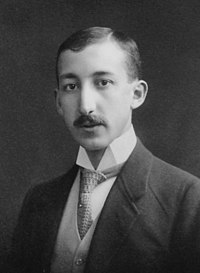George de Hevesy
| György de Hevesy | |
|---|---|
 |
|
| Born | Georg Karl von Hevesy 1 August 1885 Budapest, Austria-Hungary |
| Died | 5 July 1966 (aged 80) Freiburg, West Germany |
| Citizenship | Germany |
| Nationality | Hungarian |
| Fields | Chemistry |
| Institutions |
Ghent University University of Budapest Niels Bohr Institute ETH Zürich University of Freiburg University of Manchester Stefan Meyer Institute for Subatomic Physics |
| Alma mater | University of Freiburg |
| Doctoral advisor | Georg Franz Julius Meyer |
| Doctoral students | Max Pahl |
| Known for | |
| Notable awards |
Nobel Prize for Chemistry (1943) Copley Medal (1949) Atoms for Peace Award (1958) Fellow of the Royal Society |
| Spouse | Pia Riis (m. 1924; 4 children) |
George Charles de Hevesy (German: Georg Karl von Hevesy; 1 August 1885 – 5 July 1966) was a Hungarian radiochemist and Nobel laureate, recognized in 1943 for his key role in the development of radioactive tracers to study chemical processes such as in the metabolism of animals. He also co-discovered the element hafnium.
Hevesy György was born in Budapest, Hungary to a wealthy and ennobled family of Hungarian Jewish descent, the fifth of eight children to his parents Lajos (Louis) Bischitz and Baroness Eugenia (Jenny) Schossberger (ennobled as "De Tornya"). Grandparents from both sides of the family had provided the presidents of the Jewish community of Pest. His parents converted to Roman Catholicism. George grew up in Budapest and graduated high school in 1903 from Piarista Gimnázium. The family's name in 1904 was Hevesy-Bischitz, and Hevesy later changed his own.
De Hevesy began his studies in chemistry at the University of Budapest for one year, and at the Technical University of Berlin for several months, but changed to the University of Freiburg. There he came in contact with Ludwig Gattermann. In 1906 he started his Ph.D. thesis with Georg Franz Julius Meyer, acquiring his doctorate in physics in 1908. In 1908 Hevesy got a position at the ETH Zürich, Switzerland, yet being independently wealthy, he was able to choose his research environment. Soon he worked with Fritz Haber in Karlsruhe, Germany, then with Ernest Rutherford in Manchester, England, where he also met Niels Bohr. Back at home in Budapest he was appointed professor in physical chemistry in 1918. In 1920 he settled in Copenhagen.
...
Wikipedia
